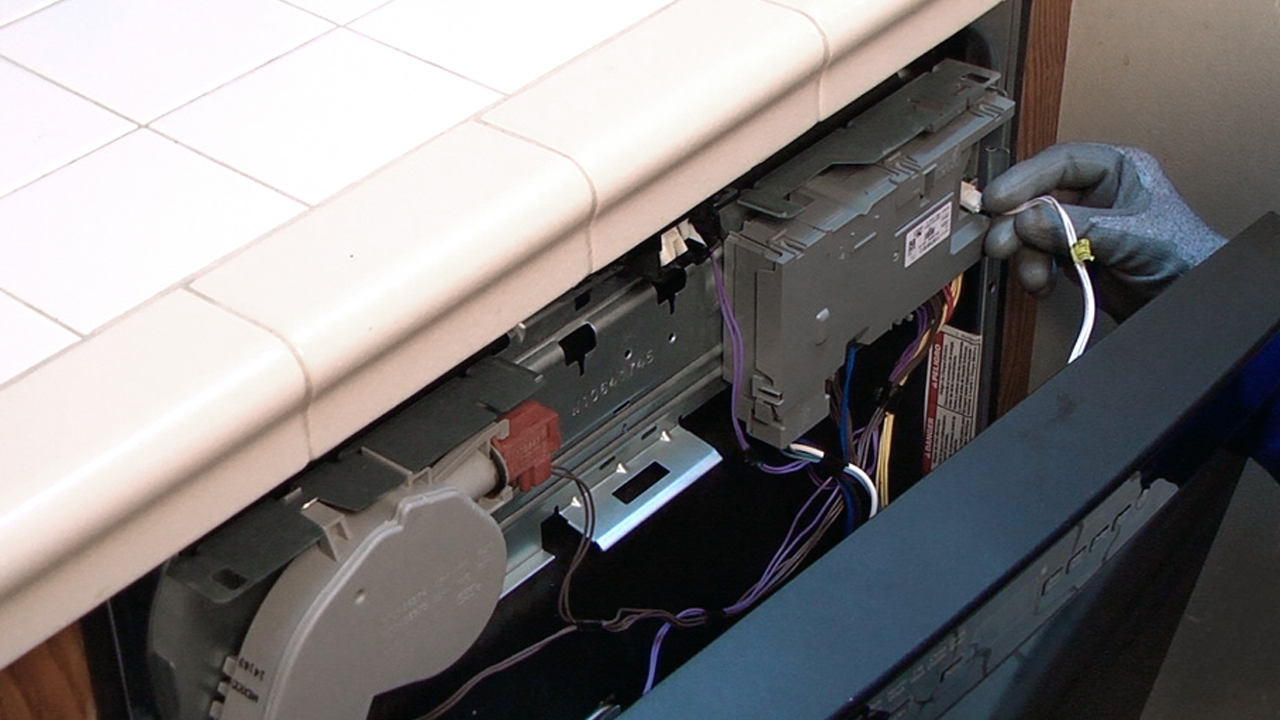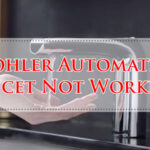A KitchenAid dishwasher with no power typically indicates an electrical issue or a tripped circuit breaker. Check your home’s electrical panel and the dishwasher’s power cord first.
Experiencing a KitchenAid dishwasher that won’t power on can be frustrating. This common kitchen appliance problem often leaves homeowners puzzled. Before calling in a professional, it’s essential to perform some basic troubleshooting. Ensuring your dishwasher is properly plugged in and inspecting the circuit breaker could quickly solve the issue.
Electrical faults or a tripped breaker are usually the culprits behind a KitchenAid dishwasher suddenly losing power. Tackling these initial steps not only saves time but also potentially avoids the cost of unnecessary repairs. Addressing power issues promptly ensures your dishwasher resumes its vital role in your kitchen, keeping your dishes clean and your routine uninterrupted.
Introduction To Kitchenaid Dishwasher Power Issues
Is your Kitchenaid dishwasher unresponsive? You’re not alone. Power issues can leave this essential home appliance out of action. Understanding the problem is key to a quick fix. Let’s dive into the common symptoms and the urgency of fixing power problems.
Common Symptoms
- Dishwasher won’t start: No response when you press the power button.
- No lights on control panel: A clear sign of no power.
- Intermittent shutdowns: Dishwasher stops mid-cycle.
Importance Of Addressing Power Problems Quickly
Food safety and hygiene depend on a functioning dishwasher. Delays in repair can lead to a pile-up of dirty dishes. Quick action also prevents potential electrical hazards. Fixing power issues promptly saves time and prevents larger, costly repairs.

Credit: www.reddit.com
Safety First: Preparing For Troubleshooting
Experiencing a Kitchenaid dishwasher with no power can be frustrating. Before diving into troubleshooting, prioritize safety. This guide prepares you for a safe and efficient diagnostic process.
Ensuring safety is crucial when dealing with electrical appliances. Follow these steps to prepare for your Kitchenaid dishwasher troubleshooting.
Turning Off The Power
- Locate your home’s breaker box.
- Identify the switch controlling the dishwasher.
- Flip the switch to the “Off” position.
- Confirm power is off with a voltage tester.
Gathering Necessary Tools
You’ll need a few tools for troubleshooting. Here’s a list:
| Tool | Use |
|---|---|
| Voltage tester | Confirm power is off |
| Screwdrivers | Open the panel |
| Flashlight | Illuminate work area |
| Owner’s manual | Reference for parts |
Initial Checks: Simple Solutions
Kitchenaid Dishwasher No Power can cause concern.
Let’s explore simple solutions that you can perform.
These quick checks often solve power issues without needing a professional.
Ensuring It’s Plugged In
Start by checking your dishwasher’s plug.
Ensure the cord connects firmly to the wall socket.
A loose plug can interrupt power supply.
Checking The Power Outlet
Test the outlet with another appliance.
If the second device works, the outlet is fine.
If not, the outlet may need repair.
Circuit Breaker And Fuse Inspection
Look at your home’s circuit breaker or fuse box.
Find the switch for the dishwasher.
Ensure it’s in the ‘on’ position.
A tripped breaker will cut power.
Replace any blown fuses.
They prevent power from reaching your dishwasher.
New fuses restore the connection.

Credit: www.youtube.com
Advanced Troubleshooting Techniques
Advanced Troubleshooting Techniques can revive a Kitchenaid Dishwasher with no power. Let’s explore how to diagnose and fix the issue.
Door Latch Examination
A faulty door latch may prevent a dishwasher from starting. Perform these steps:
- Ensure the door is firmly closed.
- Inspect the latch for debris or damage.
- Clean or adjust as necessary.
Control Panel Reset
Resetting the control panel can resolve electronic glitches. Follow this process:
- Turn off the dishwasher at the circuit breaker.
- Wait a minute before turning it back on.
- Check if the dishwasher powers up.
Wiring And Connections Review
Loose or damaged wires can cause power issues. Exercise caution and:
- Disconnect power before inspecting.
- Check for loose wire nuts or connectors.
- Secure any loose connections.
- Look for signs of wear or damage.
- Replace any faulty wiring.
When To Call A Professional
Discovering your Kitchenaid dishwasher has no power can be quite a headache. Sometimes, the issue might be simple. Other times, it’s best to seek professional help. Knowing when to call an expert can save you time and prevent further damage to your appliance. Let’s explore the scenarios where expert intervention is necessary.
Identifying Complex Electrical Issues
Electrical problems in dishwashers can be tricky. Signs like burnt wires or tripped circuit breakers need a pro’s attention. Here are things to check:
- Fuse box – Is it tripped?
- Power supply – Is it stable?
- Control panel – Does it respond?
If you spot complex wiring issues, do not attempt a DIY fix. Professionals have the right tools and knowledge to safely address these problems.
Warranty Considerations
Your Kitchenaid dishwasher might still be under warranty. If so, trying to fix it yourself could void this warranty. Check these points:
- Review your warranty terms.
- Is a professional service required?
Always contact an authorized service provider if your dishwasher is covered. They will handle repairs without risking your warranty benefits.
Remember, safety comes first. When in doubt, call a professional to get your Kitchenaid dishwasher back in power.
Preventive Measures For Future
Imagine a kitchen where your dishwasher always runs smoothly. You can make this a reality with the right care. Let’s explore how to keep your Kitchenaid Dishwasher powered up for years to come.
Regular Maintenance Tips
Regular checks keep your dishwasher happy. Follow these tips:
- Inspect the plug and cord every month.
- Clean filters often to prevent clogs.
- Check the door latch as it must close properly.
- Run a vinegar cycle monthly to clear residues.
Avoiding Common Power-related Problems
Stop power issues before they start. Remember:
- Never overload the dishwasher.
- Keep the area around the dishwasher clear.
- Use the right detergent for optimal performance.
- Ensure the power supply matches dishwasher requirements.
Understanding Error Codes
When your Kitchenaid dishwasher shows no signs of life, error codes can be your guide. These codes help diagnose the issue. Understanding what they mean is crucial for a quick fix.
Decoding Common Kitchenaid Error Messages
Kitchenaid dishwashers communicate through codes. Let’s decode the most common ones:
- F2E2 – UI disconnect. Check user interface connection.
- F4E3 – Motor not running. Inspect motor circuit.
- F6E4 – Float switch open. Ensure float is not stuck.
- F8E2 – Drain motor electrical problem. Verify drain motor function.
Actions Based On Error Codes
Each Kitchenaid dishwasher error code suggests a specific action:
| Error Code | Action |
|---|---|
| F2E2 | Reconnect or replace the UI board. |
| F4E3 | Check for obstructions or replace the motor. |
| F6E4 | Clear any debris and reset the float switch. |
| F8E2 | Inspect wiring or replace the drain motor. |

Credit: www.searspartsdirect.com
Conclusion: Ensuring Longevity And Efficiency
Keeping your Kitchenaid Dishwasher running smoothly is key. With attention and care, you ensure its longevity and efficiency. Let’s recap the steps for fixing power issues and discuss the importance of timely repairs.
Recap Of Troubleshooting Steps
- Check the power source and circuit breaker.
- Inspect the power cord for damage.
- Examine the door latch for proper function.
- Reset the dishwasher’s control board.
- Contact a professional if necessary.
The Value Of Prompt Repairs
Addressing issues quickly prevents bigger problems. Prompt repairs can save money and keep your dishwasher in top shape. A working dishwasher is efficient and saves time.
Frequently Asked Questions
Why Is My Kitchenaid Dishwasher Not Getting Power?
Your KitchenAid dishwasher may lack power due to a tripped circuit breaker, a blown fuse, or a disconnected power supply. Ensure the power cord is securely plugged in and check your home’s electrical panel for any tripped circuits or blown fuses.
How Do I Reset The Power On My Kitchenaid Dishwasher?
To reset your KitchenAid dishwasher power, press and hold the ‘Start/Reset’ button for a few seconds, or turn off the circuit breaker for one minute.
Why Would Dishwasher Have No Power?
A dishwasher might have no power due to a tripped circuit breaker, a blown fuse, or a faulty power outlet. Checking and addressing these issues can restore power.
Where Is The Fuse Located On A Kitchenaid Dishwasher?
The fuse on a KitchenAid dishwasher is typically located in the control panel. Access requires removing the inner door panel. Always ensure the dishwasher is unplugged before attempting to locate or replace the fuse for safety.
Why Is My Kitchenaid Dishwasher Not Starting?
Kitchenaid dishwashers may fail to start due to a tripped circuit breaker, faulty door latch, or a disrupted power supply. Ensure the unit is properly plugged in and the door is securely closed.
Conclusion
Navigating a Kitchenaid dishwasher with no power can be daunting, but solutions are within reach. Remember to check your power sources, circuit breakers, and the dishwasher’s door latch for common culprits. For persistent issues, professional help is a wise choice.
Keep your Kitchenaid dishwasher running smoothly with these troubleshooting tips.





